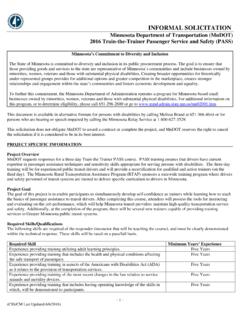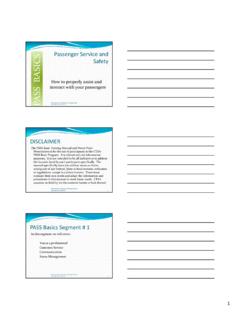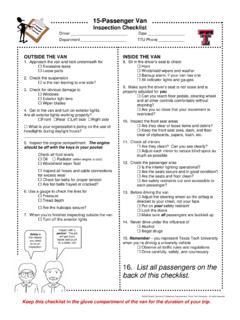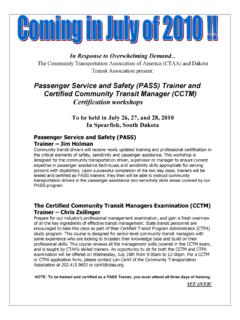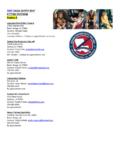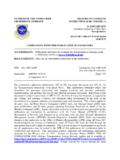Transcription of ADA Passenger Assistance Training “Train the Trainer”
1 ADA Passenger Assistance Training - train the Trainer COURSE CONTENT: Copyright 2012 Douglas J. Cross Transportation Consulting Overview: Customers with Disabilities and Older Adults Serving Customers With Disabilities: It s the Law - ADA Regulations to Eliminate Barriers (general overview, with specific provisions brought in under relevant topics below) Providing Service to Customers Who Need Extra Assistance Recognizing and Accommodating Signs of Disabilities and Aging Visible Signs Less Obvious or Non-visible Signs Providing General Assistance Provide More Time and Distance Position Vehicle Correctly & Safely - Park Close and Parallel; Adequate Room for Lift/Ramp Usage Kneel the Bus (fixed route) Watch/Guide/Safeguard Passengers on Steps Use of Ramps and Lifts for Appropriate Needs Make Sure Wheelchair Area and Priority Seating is Available (fixed route) Passenger Communications Ask first Do not question whether customer has a disability Speak clearly & directly to the customer, in non-judgmental manner Use "People First" language Give Directions and Information Provide Steadying Elbow/Hand Secure Wheelchairs and Assist with Lap/Shoulder Belts Announce Route, Stops, and Requested Locations (fixed route)
2 Report Any Difficulties Beyond the Assistance You Are Able to Give Assisting Customers With: Mobility Aids (canes, crutches, walkers, rollators) Mobility Devices (manual wheelchairs, power wheelchairs, scooters, and Segways) Portable Oxygen Supply/Respirators Age-related Slowness and Frailty Visual Impairments Guide Dogs / Signal Dogs / Service Animals Hearing Impairments Page 2 of 3 Cerebral Palsy / MS / ALS and Other Physical Impairments Cognitive Disabilities and Mental Retardation Language and Communications Impairments Epilepsy Autism Mental and emotional disorders Bus and Van Operator Guidelines: General Operations and safety Precautions Vehicle Accessibility Features and Equipment.
3 Lifts Ramps Kneeling Priority Seating (fixed route) Stop Request Devices (fixed route) Stanchions and Handholds Securement Equipment (tie-downs and lap/shoulder belts) Securement Procedures for Wheelchairs and Scooters Non-wheelchair Mobility Aids and Devices Seat Belts and Proper Usage Procedures - Both for Wheelchair Users and Others Announcing Route & Stops Including Public Address System & Automated Announcements (if so equipped for public fixed routes only) Assisting Seated Passengers to Stand or Sit Transferring from Mobility Devices to/from a Regular Vehicle Seat Reporting Complaints, Accessibility Problems, and Related safety Issues Accident and Emergency Procedures Blood-Borne Pathogens and Other Sanitary Issues Emergency Evacuation Guidelines Ergonomic safety Vehicle Operator Injury Prevention APPENDIX: Guide to ADA Regulations (NOTE - Fixed-route related items can be removed if class will all be from paratransit.)
4 Proficiency Testing Structure and Approach Trainer Qualifications Technical Components Assisting persons with visual impairments Stand and sit assist Wheelchair up/down curb and on slopes Page 3 of 3 Wheelchairs on lifts (as applicable) Wheelchairs on ramps (as applicable) Wheelchair securement Body mechanics - all tasks Passenger communication - all tasks Documentation Doug Cross Trainer Certifications Passenger Assistance : Certification for Trainers - University of Wisconsin-Milwaukee, Center for Transportation Education and Development (UWM) (valid through 11/9/2014) Passenger Assistance Techniques (PAT) TMA Assoc.
5 , Ft. Worth, Texas This was the original nationally-recognized Training program for disability awareness & Passenger Assistance . It held this position from 1976 to 1996. Although it is no longer actively offered and somewhat outdated in certain areas, the 73-page manual remains the most authoritative source for direct Passenger Assistance techniques, including tasks such bringing a wheelchair/user up or down a curb or steps, which is sometimes necessary in paratransit services . It also gives detailed procedures for safely assisting passengers to transfer from a walker or wheelchair into a regular vehicle seat. Passenger Service and safety Certification (PASS) Community Transportation Association of America (CTAA).
6 (valid through January 2014) NOTE - As of Fall 2012, the UWM course will be merged with PASS, and will be offered through CTAA. Advanced Mobility Device Securement National Transit Institute (NTI), Rutgers University This is a new course, the first ever specifically devoted to wheelchair accommodations and safety . It was developed in 2009 and originally offered at NTI s annual Transit Trainers Workshop in November 2009. I attended that first certificate class, and also contributed technical material to the course manual. Doing It Right: The Sure-Lok Safe & Secure Wheelchair Securement & Occupant Restraint Systems Training Program Sure-Lok, Inc. Copyright 2012 Douglas J. Cross Transportation Consulting
